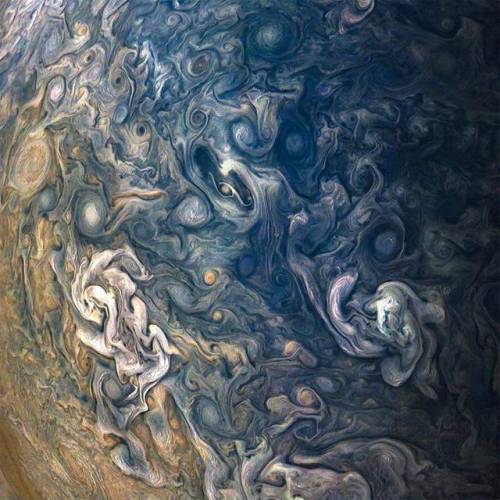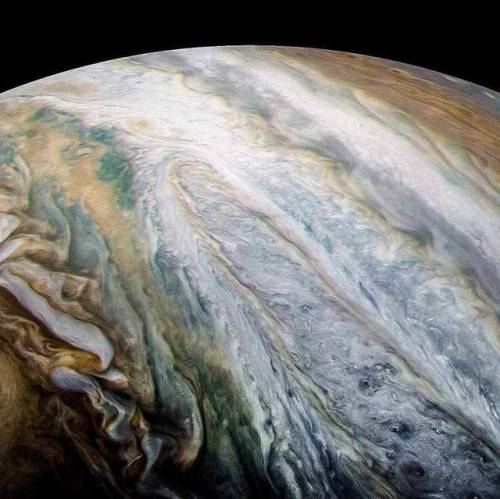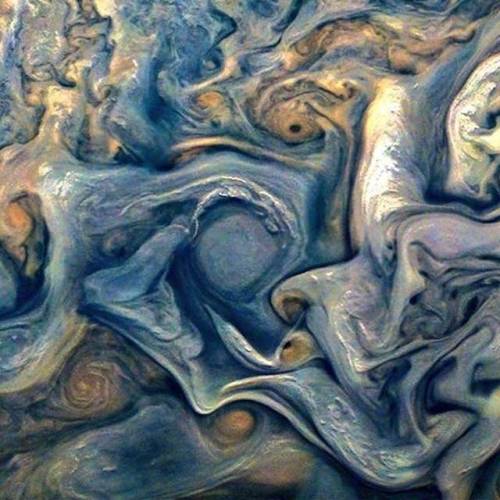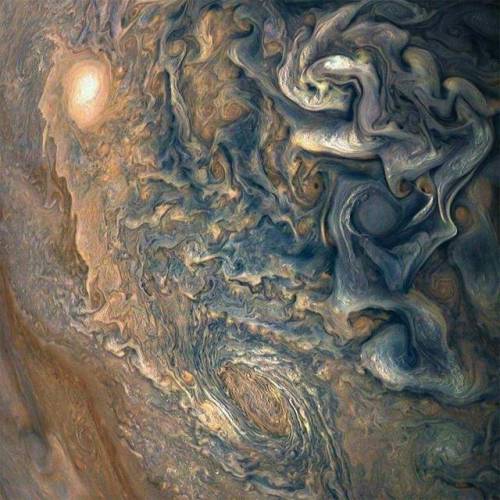3D Bennu : Put On Your Red/blue Glasses And Float Next To Asteroid 101955 Bennu. Shaped Like A Spinning

3D Bennu : Put on your red/blue glasses and float next to asteroid 101955 Bennu. Shaped like a spinning toy top with boulders littering its rough surface, the tiny Solar System world is about one Empire State Building (less than 500 meters) across. Frames used to construct this 3D anaglyph were taken by PolyCam on the OSIRIS_REx spacecraft on December 3, 2018 from a distance of about 80 kilometers. With a sample from the asteroid’s rocky surface on board, OSIRIS_REx departed Bennu’s vicinity this May and is now enroute to planet Earth. The robotic spacecraft is scheduled to return the sample to Earth in September 2023. via NASA
More Posts from Night-hides-the-world and Others




NASA has released new images of Jupiter, taken by the Juno Spacecraft.

shit man this got me emotional

“The shockwave from a 20,000 year-old supernova explosion in the constellation of Cygnus is still expanding into interstellar space. The collision of this fast moving wall of gas with a stationary cloud has heated it causing it to glow in visible as well as high energy radiation, producing the nebula known as the Cygnus Loop (NGC 6960/95). The nebula is located a mere 1,400 light-years away. The colors used here indicate emission from different kinds of atoms excited by the shock: oxygen-blue, sulfur-red, and hydrogen-green. This picture was taken with the Wide Field and Planetary Camera 2 on board the Hubble Space Telescope.”
Photo by J Hester of ASU, description via NASA.









Starry Greetings!
Here is a comic on Asteroids!
https://www.space.com/51-asteroids-formation-discovery-and-exploration.html
The Perseid Meteor Shower Is Here!

Image Credit: NASA/Bill Ingalls
The Perseids are at their peak this week!
The Perseid meteor shower, one of the biggest meteor showers of the year, will be at its brightest early in the morning on Wednesday, August 12. Read on for some tips on how to watch the night sky this week – and to find out: what exactly are the Perseids, anyway?

Credit: NASA/Bill Ingalls
Your best chance to spot the Perseids will be between 2 AM and dawn (local time) the morning of August 12. Find a dark spot, avoid bright lights (yes, that includes your phone) and get acclimated to the night sky.
Your eyes should be at peak viewing capacity after about 30 minutes; though the Moon may block out some of the dimmer meteors, you should still be able to see up to 15-20 an hour. If you’re not an early bird, you can try and take a look soon after sunset (around 9 PM) on the 11th, though you may not see as many Perseids then.

Credit: NASA/MEO
If it’s too cloudy, or too bright, to go skywatching where you are, you can try again Wednesday or Thursday night – or just stay indoors and watch the Perseids online!
Our Meteor Watch program will be livestreaming the Perseids from Huntsville, Alabama on Facebook (weather permitting), starting around 9 p.m. EDT on August 11 and continuing through sunrise.
So… why are they called the Perseids?
Because all of a meteor shower’s meteors have similar orbits, they appear to come from the same place in the sky – a point called the radiant.

The radiant for the Perseids, as you might guess from the name, is in the constellation Perseus, found near Aries and Taurus in the night sky.
But they’re not actually coming from Perseus, right?

Credit: NASA/Joel Kowsky
Right! The Perseids are actually fragments of the comet Swift-Tuttle, which orbits within our solar system.
If you want to learn more about the Perseids, visit our Watch the Skies blog or check out our monthly “What’s Up” video series. Happy viewing!
Make sure to follow us on Tumblr for your regular dose of space: http://nasa.tumblr.com
-
 thepipfalcon reblogged this · 2 years ago
thepipfalcon reblogged this · 2 years ago -
 tethys-the-aquatic-sea-godness reblogged this · 2 years ago
tethys-the-aquatic-sea-godness reblogged this · 2 years ago -
 tethys-the-aquatic-sea-godness liked this · 2 years ago
tethys-the-aquatic-sea-godness liked this · 2 years ago -
 eyekandie liked this · 2 years ago
eyekandie liked this · 2 years ago -
 declanpipkin reblogged this · 2 years ago
declanpipkin reblogged this · 2 years ago -
 communist-ant-hill liked this · 2 years ago
communist-ant-hill liked this · 2 years ago -
 cureastro reblogged this · 2 years ago
cureastro reblogged this · 2 years ago -
 fernsensei liked this · 2 years ago
fernsensei liked this · 2 years ago -
 night-hides-the-world reblogged this · 2 years ago
night-hides-the-world reblogged this · 2 years ago -
 justanothervirus liked this · 2 years ago
justanothervirus liked this · 2 years ago -
 urban-cryptid reblogged this · 2 years ago
urban-cryptid reblogged this · 2 years ago -
 awoooooubliette reblogged this · 2 years ago
awoooooubliette reblogged this · 2 years ago -
 awoooooubliette liked this · 2 years ago
awoooooubliette liked this · 2 years ago -
 everylittlenookandcranny liked this · 2 years ago
everylittlenookandcranny liked this · 2 years ago -
 starfilled-heart liked this · 2 years ago
starfilled-heart liked this · 2 years ago -
 shitposting-hobbits-to-gallifrey liked this · 2 years ago
shitposting-hobbits-to-gallifrey liked this · 2 years ago -
 ladylilithprime reblogged this · 2 years ago
ladylilithprime reblogged this · 2 years ago -
 keithspyder liked this · 2 years ago
keithspyder liked this · 2 years ago -
 crispybanditexpertalien liked this · 2 years ago
crispybanditexpertalien liked this · 2 years ago -
 im-the-bird liked this · 2 years ago
im-the-bird liked this · 2 years ago -
 maphistorich liked this · 2 years ago
maphistorich liked this · 2 years ago -
 markroome liked this · 2 years ago
markroome liked this · 2 years ago -
 whaletailradio liked this · 2 years ago
whaletailradio liked this · 2 years ago -
 si1v3rpho3n1x reblogged this · 2 years ago
si1v3rpho3n1x reblogged this · 2 years ago -
 katocrossesthecourtyard liked this · 2 years ago
katocrossesthecourtyard liked this · 2 years ago -
 dearaimee liked this · 2 years ago
dearaimee liked this · 2 years ago -
 taylorturrtle liked this · 2 years ago
taylorturrtle liked this · 2 years ago -
 thesmoke-easy liked this · 2 years ago
thesmoke-easy liked this · 2 years ago -
 ges-who liked this · 2 years ago
ges-who liked this · 2 years ago -
 ges-who reblogged this · 2 years ago
ges-who reblogged this · 2 years ago -
 roofbrahmin reblogged this · 2 years ago
roofbrahmin reblogged this · 2 years ago -
 midnight-shy liked this · 2 years ago
midnight-shy liked this · 2 years ago -
 adrastos42 liked this · 2 years ago
adrastos42 liked this · 2 years ago -
 teaandgrief liked this · 2 years ago
teaandgrief liked this · 2 years ago -
 waknatious reblogged this · 2 years ago
waknatious reblogged this · 2 years ago -
 daveogarf liked this · 2 years ago
daveogarf liked this · 2 years ago -
 newlabdakos liked this · 2 years ago
newlabdakos liked this · 2 years ago -
 cattyfantastic liked this · 2 years ago
cattyfantastic liked this · 2 years ago -
 kingduncan42 reblogged this · 2 years ago
kingduncan42 reblogged this · 2 years ago -
 kingduncan42 liked this · 2 years ago
kingduncan42 liked this · 2 years ago -
 dsaucedo liked this · 2 years ago
dsaucedo liked this · 2 years ago -
 scooter-witch reblogged this · 2 years ago
scooter-witch reblogged this · 2 years ago -
 scooter-witch liked this · 2 years ago
scooter-witch liked this · 2 years ago -
 debonnaires-tardis liked this · 2 years ago
debonnaires-tardis liked this · 2 years ago -
 eightertrek reblogged this · 2 years ago
eightertrek reblogged this · 2 years ago
Astronomy and the other wonders you witness when you look to the skies.
115 posts



